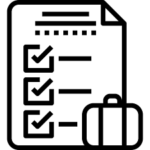English translation of Réunions interculturelles: 10 bonnes pratiques pour réduire les malentendus
Scare yourself. If you regularly have meetings with foreign partners, it happens that out of an hour of exchanges, there are 5, 10, 15 minutes, or even more, where communication is impaired due to some misunderstandings or complete misunderstandings (technical issues, loss of attention, unclear explanations, differences in language levels, accents and pronunciation, etc.).
Now, calculate how many such meetings you attend per month, then per year, and add up all those critical moments where there is no discussion of the content and you will realize the colossal loss of information they represent.
It is not possible to completely eradicate these disruptions. But they can be reduced. How? When I ask what they do to deal with them, participants in cross-cultural training very generally say the same thing: simplify expression, slow down the flow, repeat, rephrase, and then write up the minutes of the meeting.
This is very useful, but often not enough. One then turns to the many articles devoted to the challenges of intercultural communication. But we are often frustrated by the advice given. We are told that we should not assume that our partners have the same references and habits in terms of communication, that we should be “kind”, “listening”, “open and respectful”, “show empathy”. These are useful but very general postures that remind us of the abstract advice of personal development (Be yourself! Enjoy every moment!). The question remains: what can we actually do?
I propose a non-exhaustive list of actions to implement (in blue below). Some of them come from personal observations and practices; others have been mentioned by participants in intercultural trainings (I will mention it if the case). It is up to each of you to take what you from this toolbox – and to complete it in the comment section!
* * *
1. Prepare, prepare, prepare
 As much care should be taken in preparing an intercultural meeting for its non-technical aspects as for its strictly professional content. Unfortunately, we are often overwhelmed by the business expertise and the information to be shared and less involved in the formatting of our speech and the considering for cultural particularities of an efficient communication.
As much care should be taken in preparing an intercultural meeting for its non-technical aspects as for its strictly professional content. Unfortunately, we are often overwhelmed by the business expertise and the information to be shared and less involved in the formatting of our speech and the considering for cultural particularities of an efficient communication.
For example, there is a tendency to repeat or just update a presentation in one’s own language, then translate it into English and communicate it almost unchanged to foreign partners. It would be useful to consult either colleagues with extensive experience in the partner country, or locals from that country, to show them this presentation and ask for advice and whether adjustments are needed for greater effectiveness (should I start with general considerations or by sharing practical details right away? should I explain with a higher precision in the information? should I use more or less illustrations? should I convince by the strength of ideas or examples? how to gather comments and questions? etc.).
Here is a personal story. One day, I didn’t know how to start an intercultural training in Abidjan. I asked an Ivorian for advice: Come up with a list of French proverbs, split the Ivorians in small groups, ask them what they learned from them, as well as what they have in common with Ivorian proverbs and how they differ. I would never have had this brilliant idea, which effectively launched the Franco-Ivorian intercultural theme.
Moreover, a meeting, whatever it is, will be effective once each participant knows who’s who and who does what. With foreign partners, the preparation phase is all the more important given that they do not share the same professional environment and this environment can present particularities that impact communication, especially if they affect the hierarchy of relationships.
Prepare and send a simplified organization chart of your team, if possible with a picture (to personalize the relationship and anticipate the fact that such and such a member of your team is a man or a woman, information that is often obscure based on foreign first names), by specifying the involvement of each person in the project and by indicating who is n+1 and n+2 (in case the job titles of your partners are “stronger” than yours, so that they realize that despite this difference in title you are reporting to a similar level of hierarchy). Also ask for the partner team’s organizational chart to avoid putting a person from your team in contact with someone from the foreign team who is in fact one or more levels above.
During meetings in English, hunt for words in your language (if English is not your mother tongue). I get too much feedback from foreigners who are annoyed to attend presentations in English where there are still words or expressions in French (carelessness? inattention? lack of time to translate?). Make your translation with several tools for a double check, and ideally by consulting an English-speaking person. Google Translator is not enough. Translate also with Deepl, then always check the expression in its context, for example with Linguee.
2. Free the voices!
 A classic situation of misunderstandings: meetings in English. Many foreigners wonder about our relationship with English. They observe three main categories of French people who speak English: there are those who are uncomfortable, speak little or not at all; then there are those who speak too much and too fast and leave no room for discussion, which may conceal another type of discomfort, such as a fear of not understanding the foreign partners’ comments if they are ever interrupted; and those who, even if they do not speak impeccable English, are relaxed, careful to have a measured flow and to rephrase their message if they perceive that it has not been understood.
A classic situation of misunderstandings: meetings in English. Many foreigners wonder about our relationship with English. They observe three main categories of French people who speak English: there are those who are uncomfortable, speak little or not at all; then there are those who speak too much and too fast and leave no room for discussion, which may conceal another type of discomfort, such as a fear of not understanding the foreign partners’ comments if they are ever interrupted; and those who, even if they do not speak impeccable English, are relaxed, careful to have a measured flow and to rephrase their message if they perceive that it has not been understood.
An Indian woman, aware that the English spoken by Indians is often a challenge for the French and having difficulty understanding the French accent, explained to me that she had set up a small activity that was very useful for facilitating pronunciations as soon as the project kick-off meeting was held and for making the participants less hesitant to express their misunderstandings during the cooperation.
It’s very simple: everyone teaches foreign colleagues how to pronounce their first and last names, and everyone practices during the kick-off meeting. This is fun, useful for addressing each other, and very effective in relieving guilt and encouraging later sharing of misunderstandings due to different accents in English.
3. Share the context of cooperation
 Before addressing the main topic of the meeting and launching a project, it is also essential to share contextual elements that will allow each team to get to know each other better. I won’t go into the many icebreaker-type activities that provide a great way to get to know the personalities. I would just like to point out how necessary it is to go a step further and organize an exchange of contextual information useful for cooperation and communication.
Before addressing the main topic of the meeting and launching a project, it is also essential to share contextual elements that will allow each team to get to know each other better. I won’t go into the many icebreaker-type activities that provide a great way to get to know the personalities. I would just like to point out how necessary it is to go a step further and organize an exchange of contextual information useful for cooperation and communication.
For example, each team should prepare a calendar of holidays in their country and share it with the partner team explaining:
- which periods of the year the team is less available
- what the public holidays are and what they mean
- when the school vacations are and what the regional differences are (if any),
- why, for example, the month of May is very specific in France (long weekends, and also legal limit to take the remaining annual leave from the previous year)
- the best times and the best days of the week to plan a meeting,
- the team members’ vacation plan once it has been finalized.
These are not details! Many misunderstandings are related to a lack of understanding of these contextual elements that are of considerable use to each team in planning their interactions and the project management.
I would add that once we have exchanged on all these subjects it is much easier to ask more sensitive questions that are even more useful for cooperation and communication, for example: What is a meeting in your company? How do you express feedback disagreement? Why do you copy many people by e-mail? Do I have to copy them back when I reply? etc.
4. Schedule “understanding-check” breaks
 The meeting has started. A Turkish partner takes the floor and provides critical information. Suddenly, a Frenchman turns to her colleague and asks in a low voice if she has understood. The colleague explains in French. Another colleague hears them and corrects: that’s not what the Turk said! A discussion in French between team members then begins. The Turk interrupts himself and shows his annoyance.
The meeting has started. A Turkish partner takes the floor and provides critical information. Suddenly, a Frenchman turns to her colleague and asks in a low voice if she has understood. The colleague explains in French. Another colleague hears them and corrects: that’s not what the Turk said! A discussion in French between team members then begins. The Turk interrupts himself and shows his annoyance.
I have lost count of foreigners complaining about the fact that exchanges take place in French at meetings! And the opposite is true, with French people returning to express their exasperation at seeing the local team exchange in their own language. Each time, asides in a foreign language are perceived as a sign of rudeness, or even as a will to conceal.
So why not ritualize these interruptions? This was the suggestion of a Polish woman who decided that both teams should agree at the beginning of the meeting on regular one-minute breaks so that each team could discuss in its own language of its understanding of what was said by the other team. A spokesperson would then provide feedback and ask follow-up questions of the other team.
5. Meetings in workshop mode
 Stop treating the meeting as a lecture where one person delivers a message while the others listen (in the best of cases) before asking questions (in the best of worlds)! This is very often not very productive, especially if the partners prefer to preserve the harmony of the relationship instead of expressing divergent points of view. This can lead to a polite silence when many participants would have interesting comments and useful suggestions for the project.
Stop treating the meeting as a lecture where one person delivers a message while the others listen (in the best of cases) before asking questions (in the best of worlds)! This is very often not very productive, especially if the partners prefer to preserve the harmony of the relationship instead of expressing divergent points of view. This can lead to a polite silence when many participants would have interesting comments and useful suggestions for the project.
In the same vein as the breaks for checking the understanding, it would be beneficial to operate in workshop mode by planning short open sequences on a few practical questions, a case study or a request for feedback, then allowing the local team time to reflect and exchange in their own language in order to respond and then share their own comments, suggestions, reflections and questions.
This way of working must be prepared in advance by the teams’ leaders of the two countries. If there are many participants on each side, they can set up small exchange groups (between 2 and 4 people) that will be called upon regularly during the meeting. If necessary, they can even bring together the two nationalities: in person, the space must allow for meetings in small groups in coffee mode (let’s avoid the large rectangular or oval table that was designed solely for Vladimir Putin’s communication); remotely, the communication tool must allow for split sessions (thanks to COVID for having made it possible to definitively put an end to telephone conferences).
6. Communicate less directly
 One-on-one dialogue is not necessarily the best option for… dialogue. Especially if the two people don’t know each other personally. And even less if there are more than two people in the same room. In front of others, it is often psychologically very difficult to express one’s personal point of view (what if I said something stupid?), and even more difficult to express one’s lack of understanding (what if I was the only one who didn’t understand?). And coming from a so-called individualistic environment doesn’t change much.
One-on-one dialogue is not necessarily the best option for… dialogue. Especially if the two people don’t know each other personally. And even less if there are more than two people in the same room. In front of others, it is often psychologically very difficult to express one’s personal point of view (what if I said something stupid?), and even more difficult to express one’s lack of understanding (what if I was the only one who didn’t understand?). And coming from a so-called individualistic environment doesn’t change much.
Plan regular moments of written and anonymous feedback. There are many tools for this, for example Mentimeter or Padlet, whose free versions are sufficient for conducting a meeting. Contributions can be individual or collective (e.g., as a result of discussions in the subgroups mentioned above).
Provide for written redundancy
I n a project launched and managed remotely with Asian partners, the French team has great difficulty understanding the local team’s spoken English. The reverse is apparently true: meeting minutes show that much of the information shared by the French was lost during their presentation.
n a project launched and managed remotely with Asian partners, the French team has great difficulty understanding the local team’s spoken English. The reverse is apparently true: meeting minutes show that much of the information shared by the French was lost during their presentation.
It was decided to set up a written redundancy of what is presented orally on both sides. In other words, while one person is speaking, another summarizes the key points in the discussion window in writing. They do the same when a question is asked orally. It’s like the meeting mode equivalent of subtitling movies.
The process requires some dexterity but can be prepared in advance. The team develops the points of the Powerpoint presentation in writing and on the day of the meeting, they simply copy and paste them into the discussion window as they are presented orally.
Regarding the Powerpoint presentation, care should be taken to make the information appear progressively as the presentation proceeds. Too often, a slide is shown full of text all at once, which disturbs attention (hence the exciting game of looking on the slide for what is being presented, hence the even less attention to what is being said, hence the exciting game, etc.)
8. Use more visual appeal
 The quality of the infographics is a key element to reduce misunderstandings. But knowing how to illustrate a complex concept requires a certain talent. An illustration should not be too “artistic”, otherwise participants may focus only on the form, nor too abstract so that they do not spend their time looking for the meaning.
The quality of the infographics is a key element to reduce misunderstandings. But knowing how to illustrate a complex concept requires a certain talent. An illustration should not be too “artistic”, otherwise participants may focus only on the form, nor too abstract so that they do not spend their time looking for the meaning.
The French often like to demonstrate rather than show, or demonstrate before showing. This is not universal. In most contexts, people explain by example. A visual then helps to convey a message, just as an exemplary story helps to convey a lesson.
I remember a Frenchman who was managing a project with several Saudi partners in the field of armaments. His company imposed a very heavy project monitoring document (dozens of pages that each partner had to fill out monthly). As much to say that it was mission impossible to obtain this follow-up in time each month. He decided to draw a diagram in large format of the different stages of the project and to give this diagram to each of the partners, so that each month the Saudis would tell him by phone where they were very precisely on the drawing in question.
9. Reduce the surprise effect
 Too often, we think that our added value lies in the content of a meeting that we are very proud to present to others. The participants have received the agenda in advance and find out in detail what it is about during a verbal presentation. A surprise effect! And then the speaker asks : Any questions? Generally, there are questions: 1) from the manager (the question proves the position…), 2) from one or two people who usually always ask questions (who are in fact rephrasing the content presented…), 3) from a person who is waiting for a particular moment to ask a question (that well-known moment when n+1 has left and everyone thinks they are free from the meeting).
Too often, we think that our added value lies in the content of a meeting that we are very proud to present to others. The participants have received the agenda in advance and find out in detail what it is about during a verbal presentation. A surprise effect! And then the speaker asks : Any questions? Generally, there are questions: 1) from the manager (the question proves the position…), 2) from one or two people who usually always ask questions (who are in fact rephrasing the content presented…), 3) from a person who is waiting for a particular moment to ask a question (that well-known moment when n+1 has left and everyone thinks they are free from the meeting).
I am slightly exaggerating. But this phenomenon will be accentuated in very hierarchical and collective contexts: the debate is likely to be very limited and the exchanges rather sterile, not going beyond the usual thanks. With these partners, the surprise effect should be minimized: nothing is more stressful than improvising a question.
In my article The surprise effect, or the enemy of cross-cultural communication, I share the feedback from the Japanese. I remind you here: they usually send a presentation before the meeting in order to prepare their questions in advance. Because, in the end, our added value may not be to present the content but to discuss it. To do this, we need to provide as many elements as possible to prepare the discussion during the meeting.
This practice also has the significant advantage of reducing misunderstandings due to spoken English. For example, last year I met a French company that, with the same objective of reducing misunderstandings, had decided to systematize the sending of presentations before any meeting with its American partner.
10. Debriefing after the meeting
 A meeting with foreigners has taken place. They will talk about its content afterwards. They will have the opportunity to discuss what was presented in their own language. They will share between themselves what they understood (or not) and will probably have new questions.
A meeting with foreigners has taken place. They will talk about its content afterwards. They will have the opportunity to discuss what was presented in their own language. They will share between themselves what they understood (or not) and will probably have new questions.
Therefore, it is always useful for both leaders to meet on-on-one two or three days after the meeting to gather new questions, additional information needs, suggestions for action, and so on, that their collaborators may not have been able to express during the meeting.
Quelques suggestions de lecture:
- The surprise effect, or the enemy of cross-cultural communication
- Working with the French: Indians share their experiences
- The French and the demon of theory: 3 stories
- When details are monumental – 4 cross-cultural edifying stories
- Working with the French – feedback from the field
- Meetings and the Decision-Making Process in Japan: An Interview with Dr. Sagi


Derniers commentaires